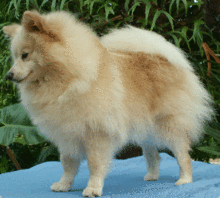German Spitz
 A Cream German Spitz (Mittel) | |||||||||||||||||||||||||||
| Other names | Deutscher Spitz | ||||||||||||||||||||||||||
|---|---|---|---|---|---|---|---|---|---|---|---|---|---|---|---|---|---|---|---|---|---|---|---|---|---|---|---|
| Country of origin | Germany | ||||||||||||||||||||||||||
| |||||||||||||||||||||||||||
| |||||||||||||||||||||||||||
| Notes | The AKC does not have its own standard and instead links to that of the FCI | ||||||||||||||||||||||||||
| Dog (Canis lupus familiaris) | |||||||||||||||||||||||||||
German Spitz is used to refer to both a breed of dog and category or type of dog. Several modern breeds have been developed from the German Spitz, and are either registered as separate breeds or as varieties of German Spitz. All the German Spitz type dogs are dogs of the Spitz type of German origin. The Großspitz, Mittelspitz, and Kleinspitz breeds of German Spitz type are also called the German Spitz in English.
The German Spitz breed
The Fédération Cynologique Internationale recognizes the German Spitz (Deutscher Spitz) under Group 5, Section 4, European Spitz. The Deutscher Spitz is one breed; names differentiate sizes and colour:[1]
- Keeshond or Wolfsspitz - wolf grey with black points; 49 ± 6 centimetres (19.3 ± 2.4 in) at withers; ca. 20 kilograms (44 lb).
- Großspitz (Giant/Large Spitz) - white, brown or black; 46 ± 4 centimetres (18.1 ± 1.6 in) at withers; 15 to 20 kilograms (33 to 44 lb).
- German Spitz (Mittel) (Medium/Standard Spitz, incl. American Eskimo Dog) - black, white, cream, brown, sable, parti-colour and more; 34 ± 4 centimetres (13.4 ± 1.6 in) at withers; 7 to 10 kilograms (15 to 22 lb).
- German Spitz (Klein) (Miniature Spitz) - white, brown or black, orange, grey-shaded and other colours; 26 ± 3 centimetres (10.2 ± 1.2 in) at withers; 4 to 5 kilograms (8.8 to 11.0 lb).
- Zwergspitz (Dwarf Spitz) or Pomeranian - orange, cream, black, white, sable, parti-colour, etc. 20 ± 2 centimetres (7.87 ± 0.79 in) at withers; 3 kilograms (6.6 lb).
The German Spitz type
Since there is no one German Spitz breed type, "German Spitz" can also be considered a subtype of the Spitz. Dogs descended or bred from various German Spitze are included in this grouping.
The Wolfspitz is also called the Keeshond and is registered as a separate breed by the Kennel Club (UK) and other registries. The Großspitz (Grossespitz) or Giant Spitz is 46 ± 4 centimetres (18.1 ± 1.6 in) high and weighs 15 to 20 kilograms (33 to 44 lb). The Keeshond and the Giant Spitz are divided primarily by colour, though the Keeshond tends to have a fuller coat and is taller and heavier. The Mittelspitz or Medium/Standard Spitz is the ancestor of, and is sometimes taken to include, the American Eskimo Dog. The American Eskimo Dog is allowed to be registered as Mittelspitz by some registries. Only the Canadian Kennel Club and the two major American kennel clubs recognize the American Eskimo Dog as a separate breed. The German Spitz (Klein) (sometimes known as the Kleinspitz) is allowed more colours than the larger German Spitz under the Fédération Cynologique Internationale standard. The Japanese Spitz, also bred from the German Spitz, is very similar to the Spitz Klein but is limited to the white colour and has a different breed history. The Zwergspitz, the Pomeranian, is also registered as a separate breed in the UK and North America.
The Kennel Club (UK) and the Australian Kennel Club recognize only the Kleinspitz and Mittelspitz. In those countries the Grossespitz is not recognized, and the Pomeranian (Zwergspitz) and Keeshond (Wolfspitz) are separate breeds. In many countries the Miniature (Klein) Spitz is also confused with the Pomeranian (Zwergspitz). Some registries and breed clubs allow various sizes of German Spitz to be interbred, others do not.
Appearance
German Spitz are similar in appearance but vary in colour. The German Spitz is usually Black, Gold/Cream and black or White-ish, but the Standard, Small and Dwarf can have various colour combinations as well. All German Spitzen have a wolf/fox-like head, double coat, highset triangular ears and a tail that is curled over the back. Although the Kleinspitz and the Pomeranian look alike, they are not the same dog. Also, although the American Eskimo Dog and Japanese Spitz look almost alike, they are in fact two different breeds with different lineages and breed histories.
History
German Spitz, like all spitzen, have many physical features found in oldest stone age fossil dogs in Central Europe, leading experts at the time to believe that the spitz is the oldest dog type. However, modern genetic evidence places them in a much more recent lineage, dating the Wolfsspitz-type to the 1800s.[2] The German Spitz was later brought to America, and was renamed American Eskimo Dog due to the widespread anti-German sentiment during World War I, although other breeds ("White Keeshonds" and Pomeranians, along with Japanese Spitz) were also used in the formation of the breed. The American Kennel club recognizes the breeds as separate.
References
- ↑ Fédération Cynologique Internationale website (accessed 06 September 2010)
- ↑ Ostrander, Elaine A. (September–October 2007). "Genetics and the Shape of Dogs; Studying the new sequence of the canine genome shows how tiny genetic changes can create enormous variation within a single species". American Scientist (online). www.americanscientist.org. pp. also see chart page 4. Retrieved 2008-09-22.
External links
| Wikimedia Commons has media related to Deutscher Spitz. |
| ||||||||||||||||||||||||||